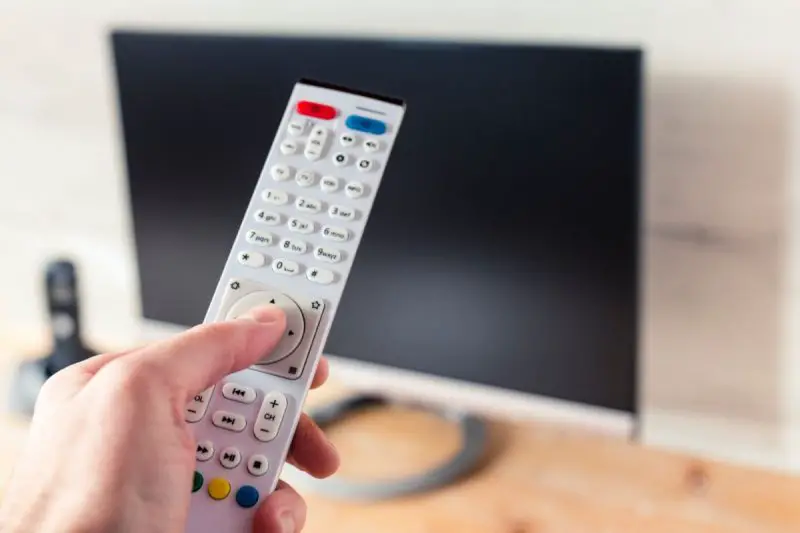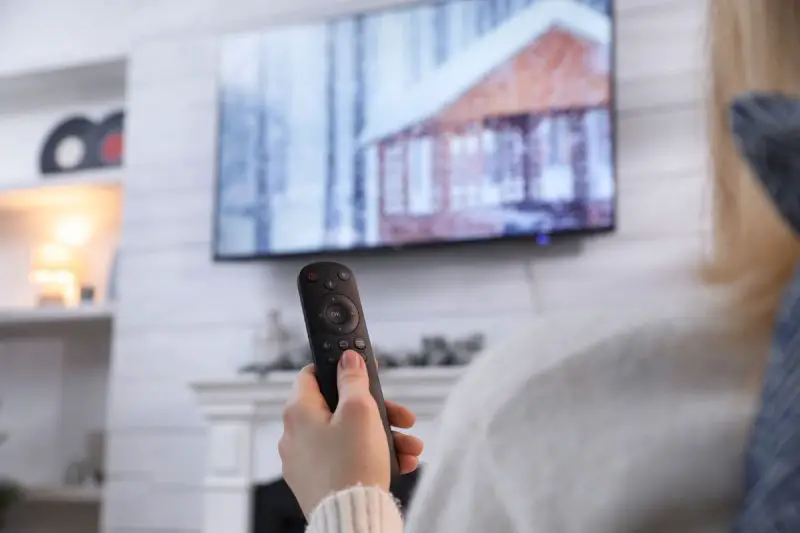A 65-inch TV is a very impressive size, and many homeowners choose to invest thousands of dollars on TVs of this size and scale every year.
You may be wondering, however, just what the benefits are of such a large television, and whether this is an investment that you are prepared to make.
To help, we have put together everything you need to know about choosing your new TV, including whether 65 inches is too large, or just right.
What Is A Smart TV?
A smart TV is one that has built-in internet connectivity, allowing you to stream content from
Netflix, Amazon Prime Video, YouTube, and other popular streaming services directly to it.
This means that you can watch movies and shows without having to use any additional devices, like laptops or smartphones.
It also allows you to access all of these services through a single app, rather than having to download them separately.
Types of TV Resolution
TV resolution is increasing and improving all the time, and there are currently three main options available: HD (1080p), 4K, and 8K.
We took a closer look at the differences between these three resolution options.
High Definition (HD)
High Definition is the current standard for televisions and has been since 2007. It’s an improvement over Standard Definition, which was introduced in 1992.
HD TVs offer much higher quality images than SD ones, but they do require more power and therefore cost more.
High-definition screens are often referred to as ‘Full HD’ because they provide full 1920×1080 pixels, and this means that high-definition pictures are clearer and sharper than those found on standard definition sets.
4k Ultra-high Definition (UHD)
Ultra-high definition is a term used to describe a type of television that provides four times the amount of detail compared to Full HD.
This means that UHD screens display 3840×2160 pixels, which is equivalent to two normal HD screens side by side.
Ultra-high-definition screens are becoming increasingly popular, especially among gamers who like to use them for watching movies and playing online games.
They are also great for watching sports events, as they allow you to view every single pixel of action on the pitch.
8k Super High Definition (SHD)
Super high definition is a term used for televisions that provide eight times the amount of detail as Full HD screens.
These screens display 7680×4320 pixels, offering incredible quality and an amazing experience for viewers.
While super high-definition screens are still relatively rare, they’re expected to become increasingly common in the future.
Screen Size And Design
There are many different types of TV screens available today, including LED, LCD, plasma, OLED, and even 3D models.
Each offers its own advantages and disadvantages, so we’ve taken a closer look at what each option entails.
LED Screens
LED screens are a relatively new technology and are rapidly gaining popularity.

They use light-emitting diodes to create bright, crisp images without consuming too much energy.
They tend to be smaller than other types of screens, but they are very thin and lightweight, making them ideal for portable devices such as tablets and smartphones.
OLED Screens
Organic Light Emitting Diode (OLED) screens are quickly becoming one of the most popular choices when buying a new TV.
They are currently used in everything from smartwatches to mobile phones, and they are set to take over our homes soon.
OLED screens are brighter and more colorful than traditional LCD or plasma screens while being far thinner and lighter.
They also consume less power than other types of screen, making them perfect for battery-powered gadgets.
LCD Screens
Liquid crystal displays have been around for decades, but it wasn’t until the early 2000s that they became widely adopted.
Today, almost all modern TVs feature LCD screens.
These screens work by using tiny liquid crystals to block out light from behind them, creating a picture.
The latest versions of LCD screens can produce incredibly vibrant colors and are extremely efficient, meaning they consume less energy than older models.
Plasma Screens
Plasma screens were once considered the best way to watch TV, but their popularity has declined significantly in recent years, largely due to the high cost, and the environmental concerns that come with them.
They are now mainly used for large public venues such as cinemas and stadiums.
These screens are made up of thousands of small glass tubes filled with gas.
When electricity passes through the screen, it causes the gas inside to glow brightly, producing an image.
Plasma screens are generally more expensive than other options, but they offer excellent viewing angles and contrast ratios.
Is The Size Of Your Television Important?
When buying a TV, there are two main things to consider: the screen size, and the resolution.
As the name suggests, the screen size refers to the diagonal measurement of the screen itself, while resolution refers to the number of pixels in each individual dot.
In general, larger screens will look better, but not always.
Screen Size
If you’re looking at TVs under 75 inches (see also ‘55 Inch TV Dimensions‘), then you’ll probably find that most of them are between 55 and 60 inches diagonally.
These sizes are considered standard and are usually good enough for viewing HD content.
However, if you’re looking at bigger TVs, then you might want to go for 70 inches or above – these offer a grander, more cinematic experience, but do require you to have enough space in your home.
Resolution
Resolution refers to the number of dots per square inch (dpi) across the entire surface of the screen. For example, a 1080p TV has 1,080 dpi, while a 4K TV has 2,560 dpi.
While higher resolutions look great, they also tend to be on the pricier side; the better the resolution of your television, the more you can expect to spend.
What Are The Advantages of A Large Television?
As we have mentioned, a 65-inch TV is definitely on the larger end of the scale – but what benefits can this really offer you?
Some of the main advantages of a larger screen include:
Better Image Quality
One of the main advantages of a larger TV screen is that you can enjoy better image quality; as well as being able to see more detail, you’ll also notice fewer compression artifacts when watching high-definition content.
Compression artifacts are those annoying lines and blotches that appear when you view images online or on mobile phones.
They are caused by the way data is compressed before being sent over the internet, and are particularly noticeable on smaller screens.

Easier To View From Different Angles
A large screen makes it easier to view content from different angles.
When you sit too close to a small screen, you may find that you need to tilt your head back to see the whole picture.
On the other hand, with a larger screen, it’s much easier to view content from every angle, allowing you to really appreciate every aspect.
Better Audio Experience
In many cases, a larger screen also allows you to enjoy a better audio experience.
You’ll be able to hear dialogue clearly, even when sitting right next to the speaker.
This means that you won’t miss out on any important information during a movie or game.
Bigger Picture
Finally, a larger screen offers you a bigger picture.
If you’re planning on using your TV primarily for movies and games (see also ‘Funko Pop Box Dimensions‘), then having a big screen will allow you to watch your favorite films and play your favorite video games without having to strain your eyes.
How Do I Choose The Best Size TV Screen For My Space?
While there are a number of advantages to choosing a bigger TV screen, this does not automatically mean that they are the best size for your space.
There is something of a science to determine this, and this is dependent on the optimal viewing distance – according to experts, this is around 1.6 times the diagonal length of the television.
There are a number of criteria that go into creating the optimal viewing distance, and these include:
Room Size
The size of your room is perhaps the most significant consideration when choosing the best size TV screen for your space, as this will affect how far away you should position your television.
Ideally, you want to place your television in such a way that you can comfortably see the whole screen from your seating area – if the screen is too large and your room too small, you may struggle to see the whole picture.
How You Plan To Display The Television
The best size TV for your room is also determined by whether you plan to place the TV on a stand, or hang it on the wall; the latter can increase your optimal viewing distance by around a foot, allowing you to go slightly larger on the size of your TV.
The Layout Of Your Room
You should also consider the layout and existing furniture of your room; will you be able to enjoy and appreciate a bigger screen with the space that you have? Will you be able to fit everything else that you need in the room?
Your Budget
Of course, one of the biggest considerations when buying a new TV is your budget.
While some people prefer to splurge on a huge screen, others choose to buy a cheaper model that fits their needs perfectly.
Final Thoughts: Do I Need A 65-Inch TV?
A 65-inch TV has its benefits, but whether it is the best choice for you is ultimately a personal decision, depending on a number of factors.
If you have the space, the budget, and the desire, however, then there is no reason that a 65-inch TV cannot become part of your living space today!
- What Size is Regular Printer Paper? Quick Guide for Paper Dimensions - June 18, 2023
- What Size is My Monitor: A Comprehensive Guide - June 18, 2023
- How Big is Italy Compared to the US? A Concise Comparison - June 16, 2023

